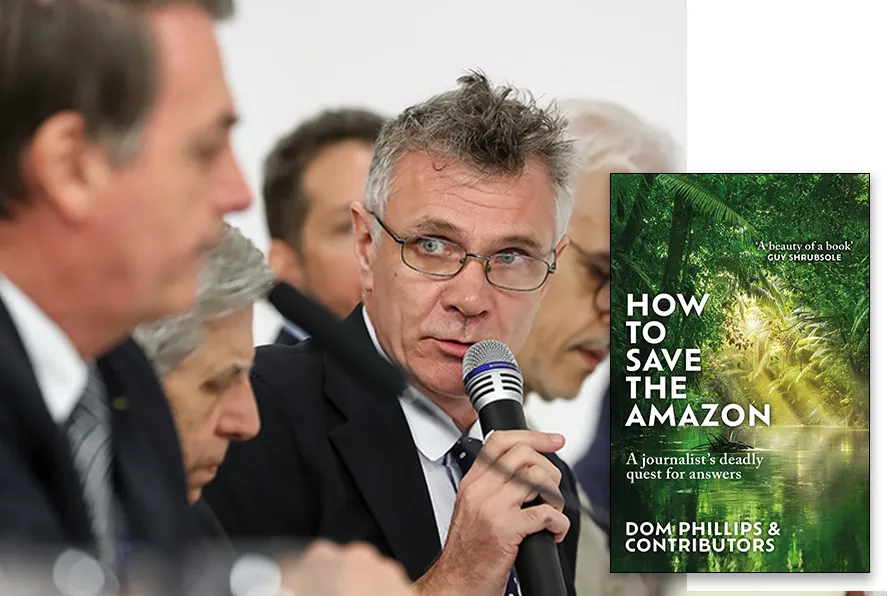MARIA DUARTE is swept along by the cocky self-belief of a ping-pong hustler in a surprisingly violent drama
GAVIN O’TOOLE examines the fatal relationship between environmental crimes and politics in Brazil and the inspiration provided by Indigenous people

 FACE TO FACE WITH THE PROBLEM: Journalist Dom Phillips confronts the then Brazilian President Jair Bolsonaro, July 19 2019 [Pic: Marcos Correa/Presidencia da Republica/CC]
FACE TO FACE WITH THE PROBLEM: Journalist Dom Phillips confronts the then Brazilian President Jair Bolsonaro, July 19 2019 [Pic: Marcos Correa/Presidencia da Republica/CC]
How to Save the Amazon: A Journalist’s Deadly Quest for Answers
Dom Phillips and Contributors, Bonnier Books, £22
WE would like to think that the right-wing populism of Jair Bolsonaro is the main target of the writers who have picked up the mantle of murdered journalist Dom Phillips to complete the book he was writing when he was killed in June 2022. After all, it was in the climate of increasingly violent hostility towards those defending the Amazon nurtured by the then Brazilian president that Phillips and the Indigenous expert Bruno Pereira were shot. As one commentator observed at the time: “The Bolsonaro government’s fingerprints are all over this tragedy.”
But the simple truth is that Luiz Inacio Lula da Silva, Brazil’s current leader — who has done more than most to protect the region — would also benefit from reading this book.
Lula was elected in large part for his pledges to preserve the Amazon and uphold Indigenous peoples’ right to live in their ancestral lands — diametrically opposed to the catastrophic reversal of protections under Bolsonaro.
Yet there have been many instances, starting with the summit Lula convened in August 2023 of Amazonian countries which failed to agree legally binding commitments to protect the rainforest, where good intentions have been undermined by the instinct to promote growth.
Everyone accepts that the Workers’ Party president has the best interest of Amazonia at heart, but a structural problem that resurfaces throughout this unique book is the development model with which he must work.
This is captured well by Federico Quitadamo, an Italian who gave up a career in private equity to join Amazon conservation efforts, when he says: “The fact is, is that as long as you work within the capitalist system, you can’t save the Amazon.”
Like most countries in the global South caught in the web of an international economic structure in which their role is to supply commodities, Brazil’s left-wing government is rendered impotent by the tension between conservation and development. It is a tension laid bare on an epic scale in the Amazon, as Phillips makes clear on his many journeys through the forest to visit Indigenous people resisting the onslaught of extractivism — but also a global fault-line in the battle against capitalism.
It was this tension that explained Marina Silva’s resignation as environment minister from the first Lula government, although she has returned to this position, and it was thrown into dramatic relief yet again in August when Brazil suspended the soy moratorium, a key agreement protecting the rainforest.
How to Save the Amazon is simultaneously an effort to grapple with this tension between conservation and development by considering concrete solutions to the many issues it raises, while being a testament to two environmental martyrs.
Dom Phillips had figured out that it was insufficient for journalists simply to record the destruction, and incumbent on them to offer ways of halting it. Accordingly, each chapter explores a key issue confronting the Amazon in order to tease out a viable conservation strategy.
The book examines the legal framework within which efforts to save the forest must operate alongside the endemic law-breaking that propels insatiable resource extraction. The fatal relationship between environmental crimes and politics in Brazil is put into context by the extremely powerful agribusiness and livestock lobbies. In such a situation, vast multinational meat companies are constantly supplied by small ranchers with cattle raised on deforested land but made invisible by flaws in traceability regulations.
Among the causal factors of this mess of destruction is a corporate culture quick to turn a blind eye to abuse of otherwise laudable rules. Among the viable solutions to it are the strategic use of smart technology and well-proven methods of sustainable ranching.
How to Save the Amazon considers how agroforestry, sustainable fishing — but also urban poverty reduction — can play a role in providing the livelihoods that are the motives of migration to the forest.
But the most recurrent theme is the inspiration already provided by Indigenous people defending nature that can drive sustainable solutions to deforestation, payment for ecosystem services, and the bioeconomy.
It is in this vein that the book concludes, pointing to the Indigenous intellectuals who, as Beto Marubo and Helena Palmquist note in the afterword, have published some of Brazil’s most excoriating critiques of industrial capitalism.
They know instinctively what we all feel in our bones: the struggle to save the Amazon is ultimately the same struggle undertaken by workers from Britain to Brazil against capitalism.










